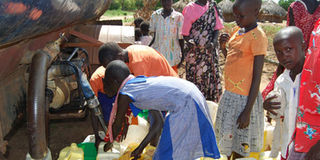Water prices increase as dry spell hits Rakai, Kyotera

In the rest of the rural sub-counties, water prices vary from Shs800 to Shs1, 500 per 20-litre jerrycan. FILE PHOTO
What you need to know:
- Costly. Due to the increased water scarcity, a 20-litre jerrycan of water now costs Shs2,000 up from Shs500 in the past one month.
- According to the 2014 National Housing and Population Census, more than 15,000 residents in the districts of Rakai and Kyotera depend on springs and boreholes. Of these, 11,072 of residents in urban areas access piped water although complain about the inconsistence in supply while more than 492,371 others still depend on wells in form of ponds.
Rakai/Kyotera. Prices for water in the two districts of Rakai and Kyotera have shot up in the past couple of months due to a long dry spell experienced by the two districts.
In the three sub-counties of Ddwaniro, Buyamba and Kagamba in Rakai, a 20-litre jerrycan of water now costs Shs2,000 up from Shs500 in the past one month.
In the rest of the rural sub-counties, water prices vary from Shs800 to Shs1, 500 per 20-litre jerrycan.
Mr Timothy Byaruhanga, a water vendor in Kyotera Town, says they now fetch water in the night to avoid long queues during the day so that they can adequately serve the big number of consumers in the area.
“Water taps have run dry and we can spend two weeks without water. Most residents are already complaining about our water charges,” Mr Byaruhanga said during an interview last Saturday.
Due to the hiked water prices, residents who cannot afford paying some money to buy water are forced to draw water from swamps and ponds, which are shared with animals.
The water is evidently dirty, unsafe and not fit for human consumption, a situation that residents say is exposing them to diseases.
Sharing with animals
Ms Beatrice Katongole, a mother of six and a resident of Kongonta Village in Ddwaniro Sub-county, says she wakes up at 4am to fetch water from the swamp before it is polluted by animals during day.
She appealed to government to provide water harvesting facilities to store enough water when rainy season starts.
“We travel three kilometers from our home and once we fail to wake up early, we find long queues there,” she says.
Although some areas, especially in central region, received some substantial rain in the past three weeks, January to March is usually a dry season in most parts of Uganda.
Meteorologists under Uganda Meteorological Authority (UMA) predict that rain will start in March.
Ms Katongole says she is worried that school going children who reported back to school last Monday may miss classes since they have to first fetch water.
The Ministry of Water, NGOs and the authorities in both districts have been coming up with various strategies to help the community access water by constructing boreholes and dams, but most of them last for a short period and break down while others remain incomplete.
Some of the stalled water projects in the area include Kagamba multi-purpose water project, which was planned to have a dam covering two-and-a half kilometres to produce water for irrigation, livestock and domestic use.
Other projects are Lwamaggwa-Lwanda Phase II, Buyamba-Ddwaniro-Kibaale Kyarulangira water supply, Lwanda-Kooki Phase II, Kirumba-Kachanga project, Kakuuto-Kabonera water project and Beteremu-Nabigasa water project.
Mr Francis Muwanga, the Rakai District water officer, says most of these water projects are under second feasibility studies and would be completed soon.
Mr Abas Bukenya, a farmer in Lwamaggwa Sub-county, says water scarcity is not only affecting domestic work, but has also crippled agricultural activities.
The two districts are endowed with vast water sources, which include Lakes Victoria, Kacheera and Kijjanabarola, River Kagera, swamps, wells and springs.
However, the districts are failing to use them to address the problem of water scarcity for years.
Govt projects
Last year, the Ministry of Water and Environment launched another bulk project that will centre its supply at Kamengo in Rakai District to pump water directly from Lake Victoria with a treatment centre at Malembo, along the shores of the lake.
Mr Sam Cheptoris, the minister of Water and Environment, says the first phase of the project will benefit sub-counties in a 200km radius before rolling it out in other areas in the two districts.
Mr Benon Robert Mugabi, the Rakai District chairperson, says although bulk water projects are important, some areas urgently need simple dams.
“A mega project, which may take long time to take off is not what people want now. They are in dire need of water and government should swiftly come in,” he says.
Mr Amos Mandela, the Buyamba county MP, advises residents, especially farmers, who can afford drilling their own boreholes, to engage government to complete the existing water projects.




